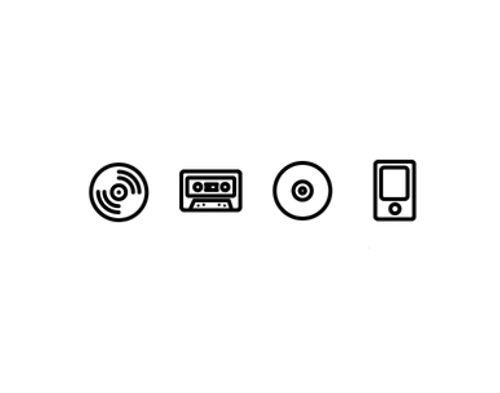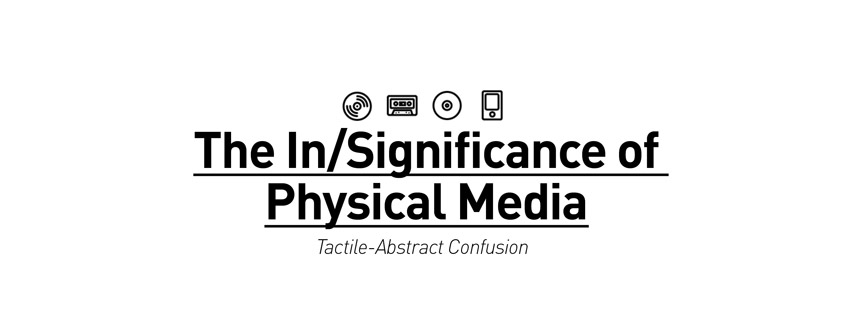The In/Significance of Physical Media, A Tactile-Abstract Confusion
 Thirsty for JUICE content? Quench your cravings on our Instagram, TikTok and WhatsApp
Thirsty for JUICE content? Quench your cravings on our Instagram, TikTok and WhatsApp

Text Alfonso Gomez
“Only ‘90s kid would remember this!”
So exclaims a clickbait piece featuring an image of a cassette tape side-by-side a pencil. Technological limitations, such as having to rewind or respool a tape as referenced in the hackneyed meme mentioned, can be so infatuating to the nostalgic – enough that one would develop animosity for those who either refuse to reminisce such a thing fondly or those who were too young to know how they – the older generation – used to live. Let’s not discuss the misguided want for the archaic here – that’s a whole other floodgate to open – instead, what can be surmised from such an instance of nostalgia is the sheer power physical media can have over us, particularly when its significance is diminished post-mp3 and the advent of cloud storage.
To boil it down to its essence, a piece of music you own isn’t just the medium carrying it – it’s the immaterial as well; there is no physical body to the art itself. Tactility plays no role in the enjoyment of music, but after a century of audio recording, love for music is linked with whatever it is that’s responsible for performing or merely replaying music, be it the artistes themselves or the recording medium. While the former is what should ultimately be appreciated, the latter is, of course, an art form in itself – any nostalgic music buff would gush about cover sleeves, album art, the extraneous packaging of a limited series, and so forth. The combination of the two tacitly creates what could be called a tactile-abstract conflation. Stripped off its physical art, music is merely something that exist only in the abstract ether – years of associating a collection of songs for the casing containing the CD/cassette/vinyl plate containing said songs have made ‘the album’ not just the tracks recorded, but the entire package of recording medium-packaging-cover/sleeve art. Anything less, especially one that can’t be held and touched, is an affront.
In the streaming age, album art doesn’t amount more than just the thumbnail on your Spotify or iTunes. It is, admittedly, reduced in importance, but even acolytes of the digital age are referencing the tangible to bring back album art.
“Music is more than a playlist.”
The above tagline by Whitestone says as much. The fledgling startup is a platform “to create, collect and truly enjoy music online” by bringing the album to the internet via interactive albums and videos. If its introductory video were to be believed, Whitestone’s idea of the album – as a packaged art, not just a playlist – sees animated cover art, interactive music, 3D space, and pretty much anything that would benefit from having a website as your ‘album art’. To quote its founder, “Why is the album artwork still a square?” Though this is admittedly some future shit that we wouldn’t see come to fruition anytime soon, surprisingly, locally we already have something similar to this hypothetical future already
To be obvious about it, being a free downloadable release, DANGERDISKO’s debut LP Hedonism doesn’t come in a physical form, of course. However, that didn’t deter the duo from having an album art – albeit in digital form. Going above and beyond of the expected sleeve + cover art, their dangerdisko.com is an interactive experience that includes a track-by-track narrative coupled with animated gifs – the concept of a concept album expanded upon.
Then there’s international act j.viewz, whose The DNA Project went straight into the future with a fully-formed site that allows fans to discover the ‘DNA’ of each track off his forthcoming release. Fully utilising HTML5, the site allows fans to peak into the makings of each track (its ‘DNA’) via video explanations, sounds used that even allow users to download them for their own purposes, and stems for remixing. In some instances, users can even influence the forthcoming release by uploading their own files for j.viewz’s own use. All in order to – as their mission statement said – create “a new kind of album that is digitally interactive, collaborative, and helps redefine the way we create and present music.”
Perhaps with the computer itself as a tactile aspect of the album, physical media aren’t obsolete, they just moved from the vinyl to the cassette to the CD right back to vinyl again, and now to — well — the computer.
Alfonso Gomez hasn’t owned music in a physical format in a very long time.

 Get Audio+
Get Audio+ Hot FM
Hot FM Kool 101
Kool 101 Eight FM
Eight FM Fly FM
Fly FM Molek FM
Molek FM